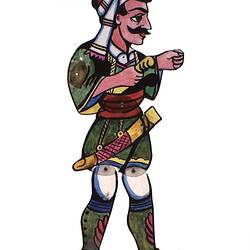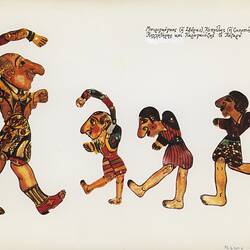Summary
This briefcase was made in 1978 by Dimitri Katsoulis at his home in Port Melbourne and used in his subsequent performances in Victoria and in South Australia from 1978 to 1991. Dimitri Katsoulis migrated to Australia in 1974 to escape a regime that repressed Greek artists. He had trained in Greece with theatre and film companies as an actor and technician. A master of the traditional Greek shadow puppet theatre, his performances explored contemporary issues such as the isolation of migrant women and children. Unable to obtain funding and support, he returned to Greece in 1991, leaving his entire collection to the people of Victoria. It includes 32 shadow puppets and around 170 props, set backdrops and technical tools and stage equipment. Dimitri has since returned to Melbourne and assists the Museum to continue to document this rich art form within both local and international contexts.
The briefcase was attached to the hand of Karaghiozis, a character in the centuries-old Greek Shadow Puppet Theatre (Karaghiozis) tradition. It is used in many plays as an object for carrying documents and whatever else may fit in it. In the play 'Karaghiozis the Doctor' , when Karaghiozis finally agrees to say that he is a doctor, he says to the Pasha, 'You go now and I will get ready, gather my equipment and come to Sarai to cure the Vizier's (the Veziris') daughter.' He then enters his shack and asks Kolitiris to put in his briefcase a saw, hammer, pliers, nails, thumb tacks, sandpaper, plaster, cement and some grout. He then puts on his faded full dress coat. Karaghiozis goes to Sarai and through various tricks he realises that the Vizier's (the Veziris') daughter is not ill but she is feigning illness because she is in love with a man of whom her father does not approve. Karaghiozis tricks the Vizier (the Veziris) by telling him that his daughter will die unless she marries the man she loves. The Vizier (the Veziris) is forced to allow them to marry.
Information supplied by Greek Shadow Puppet Theatre master Dimitri Katsoulis, 2007.
Physical Description
A two-dimensional shape, cut from white, plastic-coated cardboard, in the shape of a briefcase. Both sides have been decorated with horizontal red stripes. A small piece of brown packing tape is attached to the handle.
Significance
This collection of puppets, props, stage sets, and technical tools and equipment relating to traditional Greek Shadow Puppet Theatre is unique in Australia and rare in international public collections. The history of Greek Shadow Puppet Theatre, its puppet characters and the methodology of its performance has been recorded in partnership with the puppet master to whom the collection belonged. The collection is highly significant both as documentation of an important cross-cultural, centuries-old art form, and as an example of the transnational migration of cultural activity between Greece and Australia. It is a collection which was created and performed in Greece and Australia from the mid to late twentieth century, by two puppet masters, who transported the tradition between two countries. Abraam Antonakos came to Australia in 1977 to perform the puppet theatre and then deposited the puppets with Dimitri Katsoulis, who had migrated to Australia in 1974. Dimitri's story becomes one of migration experience, cultural maintenance and adaptation, and finally return migration and the discontinuance of this cultural art form in Australia.
More Information
-
Collection Names
-
Collecting Areas
-
Acquisition Information
Purchase
-
Maker
Mr Dimitri Katsoulis, Melbourne, Greater Melbourne, Victoria, Australia, 1978
-
User
Mr Dimitri Katsoulis, Australia, 1978-1991
Dimitri was given the puppet by Abraam in 1977 and then used it in his performances in Australia until 1991. -
Classification
-
Category
-
Discipline
-
Type of item
-
Overall Dimensions
7 cm (Length), 4.5 cm (Height)
-
References
[Link 1] Malkin, Michael, R. Traditional and Folk Puppets of the World, A.S. Barnes & Co., Inc., N.J., 1977; Simmen, Rene, The World of Puppets, Elsevier, Phaidon, London, 1975; Hogarth, Ann & Bussell, Jan, Fanfare for Puppets!, David & Charles Publishers Ltd, USA, 1985; Yayannos, A & Ar and Dingli, J. The World of Karaghiozis, 1976
-
Keywords
Cultural Maintenance, Greek Communities, Greek Immigration, Karaghiozis Theatre, Shadow Puppetry, Theatres, Working Life



